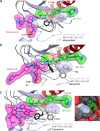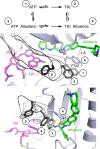Molecular basis for cooperative binding and synergy of ATP-site and allosteric EGFR inhibitors
- PMID: 35534503
- PMCID: PMC9085736
- DOI: 10.1038/s41467-022-30258-y
Molecular basis for cooperative binding and synergy of ATP-site and allosteric EGFR inhibitors
Abstract
Lung cancer is frequently caused by activating mutations in the epidermal growth factor receptor (EGFR). Allosteric EGFR inhibitors offer promise as the next generation of therapeutics, as they are unaffected by common ATP-site resistance mutations and synergize with the drug osimertinib. Here, we examine combinations of ATP-competitive and allosteric inhibitors to better understand the molecular basis for synergy. We identify a subset of irreversible EGFR inhibitors that display positive binding cooperativity and synergy with the allosteric inhibitor JBJ-04-125-02 in several EGFR variants. Structural analysis of these complexes reveals conformational changes occur mainly in the phosphate-binding loop (P-loop). Mutation of F723 in the P-loop reduces cooperative binding and synergy, supporting a mechanism in which F723-mediated contacts between the P-loop and the allosteric inhibitor are critical for synergy. These structural and mechanistic insights will aid in the identification and development of additional inhibitor combinations with potential clinical value.
© 2022. The Author(s).
Conflict of interest statement
M.J.E. is a consultant to Novartis, and the Eck laboratory receives or has received research funding from Novartis, Takeda, Sanofi, and Arbella. P.A.J. has received consulting fees from AstraZeneca, Boehringer Ingelheim, Pfizer, Roche/Genentech, Takeda Oncology, ACEA Biosciences, Eli Lilly and Company, Araxes Pharma, Ignyta, Mirati Therapeutics, Novartis, LOXO Oncology, Daiichi Sankyo, Sanofi Oncology, Voronoi, SFJ Pharmaceuticals, Takeda Oncology, Transcenta, Silicon Therapeutics, Syndax, Nuvalent, Bayer, Esai, Biocartis, Allorion Therapeutics, Accutar Biotech and Abbvie; receives post-marketing royalties from DFCI owned intellectual property on EGFR mutations licensed to Lab Corp; has sponsored research agreements with AstraZeneca, Daichi-Sankyo, PUMA, Boehringer Ingelheim, Eli Lilly and Company, Revolution Medicines, and Astellas Pharmaceuticals; and has stock ownership in Gatekeeper Pharmaceuticals. N.S.G. is a founder, science advisory board member (SAB) and equity holder in Syros, C4, Allorion, Jengu, B2S, Inception, EoCys, Larkspur (board member) and Soltego (board member). The Gray lab receives or has received research funding from Novartis, Takeda, Astellas, Taiho, Jansen, Kinogen, Arbella, Deerfield, and Sanofi. The remaining authors declare no competing interests.
Figures






Similar articles
-
Uncovering the Structural and Binding Insights of Dual Inhibitors Simultaneously Targeting Two Distinct Sites on EGFR Kinase.J Phys Chem B. 2023 Dec 21;127(50):10749-10765. doi: 10.1021/acs.jpcb.3c04337. Epub 2023 Dec 6. J Phys Chem B. 2023. PMID: 38055900
-
Molecular mechanism study of EGFR allosteric inhibitors using molecular dynamics simulations and free energy calculations.J Biomol Struct Dyn. 2022 Aug;40(13):5848-5857. doi: 10.1080/07391102.2021.1874530. Epub 2021 Jan 18. J Biomol Struct Dyn. 2022. PMID: 33459177
-
Single and Dual Targeting of Mutant EGFR with an Allosteric Inhibitor.Cancer Discov. 2019 Jul;9(7):926-943. doi: 10.1158/2159-8290.CD-18-0903. Epub 2019 May 15. Cancer Discov. 2019. PMID: 31092401 Free PMC article.
-
Treatment of Brain Metastases of Non-Small Cell Lung Carcinoma.Int J Mol Sci. 2021 Jan 8;22(2):593. doi: 10.3390/ijms22020593. Int J Mol Sci. 2021. PMID: 33435596 Free PMC article. Review.
-
EGFR C797S mutation mediates resistance to third-generation inhibitors in T790M-positive non-small cell lung cancer.J Hematol Oncol. 2016 Jul 22;9(1):59. doi: 10.1186/s13045-016-0290-1. J Hematol Oncol. 2016. PMID: 27448564 Free PMC article. Review.
Cited by
-
In Silico Exploration of Novel EGFR Kinase Mutant-Selective Inhibitors Using a Hybrid Computational Approach.Pharmaceuticals (Basel). 2024 Aug 23;17(9):1107. doi: 10.3390/ph17091107. Pharmaceuticals (Basel). 2024. PMID: 39338272 Free PMC article.
-
Quinazolinones as allosteric fourth-generation EGFR inhibitors for the treatment of NSCLC.Bioorg Med Chem Lett. 2022 Jul 15;68:128718. doi: 10.1016/j.bmcl.2022.128718. Epub 2022 Apr 1. Bioorg Med Chem Lett. 2022. PMID: 35378251 Free PMC article.
-
Genomic mapping of copy number variations influencing immune response in breast cancer.Front Oncol. 2022 Sep 1;12:975437. doi: 10.3389/fonc.2022.975437. eCollection 2022. Front Oncol. 2022. PMID: 36119512 Free PMC article.
-
Linking ATP and allosteric sites to achieve superadditive binding with bivalent EGFR kinase inhibitors.Res Sq [Preprint]. 2023 Sep 13:rs.3.rs-3286949. doi: 10.21203/rs.3.rs-3286949/v1. Res Sq. 2023. Update in: Commun Chem. 2024 Feb 20;7(1):38. doi: 10.1038/s42004-024-01108-3. PMID: 37790373 Free PMC article. Updated. Preprint.
-
Enhancement of Inhibitory Activity by Combining Allosteric Inhibitors Putatively Binding to Different Allosteric Sites on Cathepsin K.Molecules. 2023 May 19;28(10):4197. doi: 10.3390/molecules28104197. Molecules. 2023. PMID: 37241936 Free PMC article.
References
-
- Sung H, et al. Global Cancer Statistics 2020: GLOBOCAN estimates of incidence and mortality worldwide for 36 cancers in 185 countries. CA: Cancer J. Clinicians. 2021;71:209–249. - PubMed
-
- Gridelli C, et al. Non-small-cell lung cancer. Nat. Rev. Dis. Prim. 2015;1:45–62. - PubMed
-
- Siegel RL, Miller KD, Fuchs HE, Jemal A. Cancer Statistics, 2021. CA: Cancer J. Clinicians. 2021;71:7–33. - PubMed
Publication types
MeSH terms
Substances
Grants and funding
LinkOut - more resources
Full Text Sources
Medical
Research Materials
Miscellaneous

